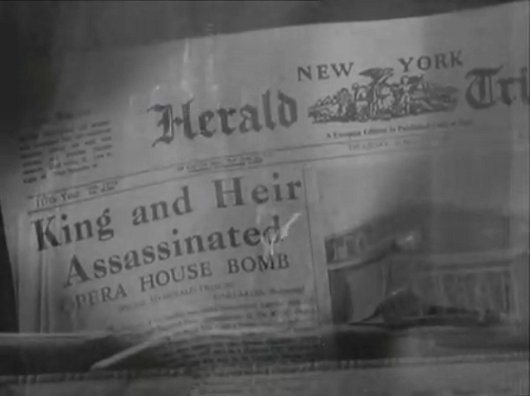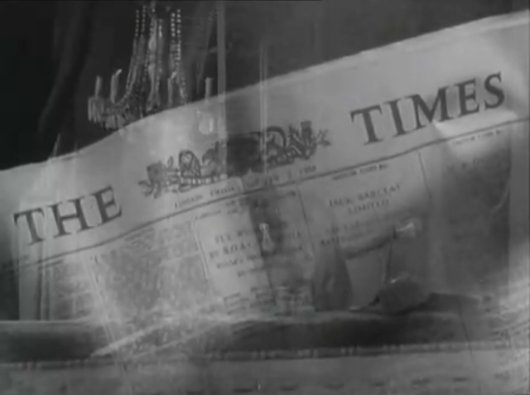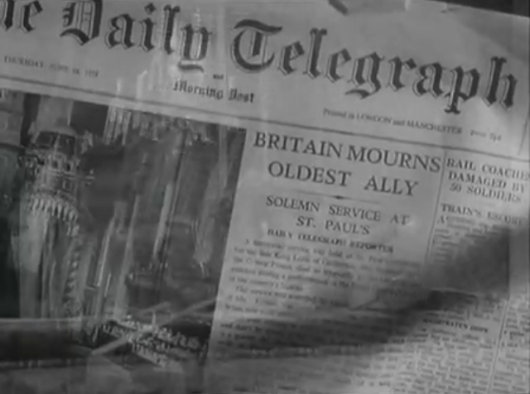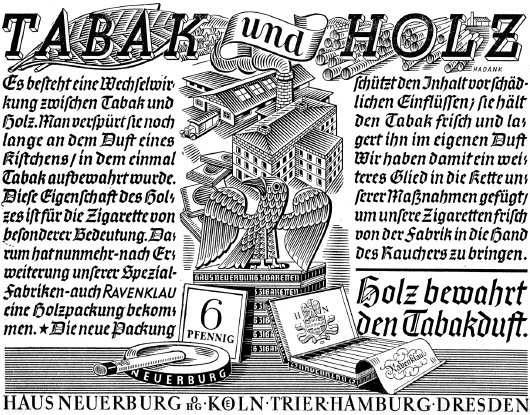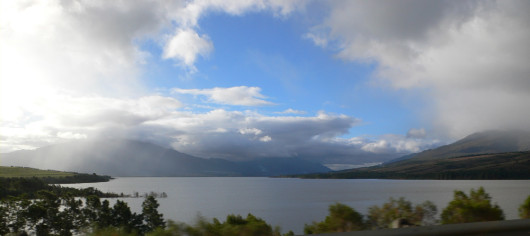2009 November
About Andrew Cusack
 Writer, web designer, etc.; born in New York; educated in Argentina, Scotland, and South Africa; now based in London.
Writer, web designer, etc.; born in New York; educated in Argentina, Scotland, and South Africa; now based in London. read more
News
Blogs
Reviews & Periodicals
Arts & Design
World
France
Mitteleuropa
Knickerbockers
Argentina
The Levant
Africa
Cape of Good Hope
Netherlands
Scandinavia
Québec
India
Muscovy
Germany
Academica
The Messiah in the Sportpalast
The following feuilleton was written before Hitler became the master of Germany. The scene is the Berlin Sportpalast, the largest indoor arena in the world when it opened in 1910 and, at this time, the setting for the rallies of the various political parties vying for control of the Weimar Republic.
On the night of the Horst Wessel commemoration Hitler speaks in the Berlin Sportpalast. People who have neither seen nor heard him will perhaps never fully understand the significance of the profoundly ominous mind-set that has developed in Germany since the war. The reality — Hitler’s version of reality and its full implications — goes far beyond anything you might read in the newspapers, or imagine. Here is that reality, drawn from the life. (more…)
Tibetan Word of the Day
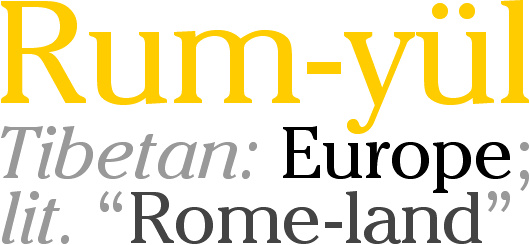
Our Tibetan word of the day is Rum-yül, the language’s traditional word for “Europe”.
The word literally means “Rome-land”, giving a certain Bellocian tone to the Tibetan language — it was Belloc, after all, who said “Europe is the Faith; the Faith is Europe”.
Notes of the Netherlandic Church II
Archbishop Eijk chooses tradition-friendly priest as his cathedral rector
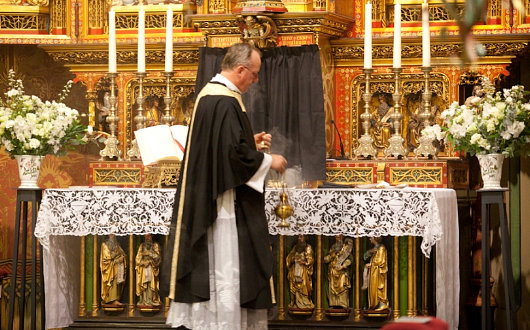
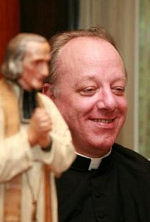
Fr. Harry Van der Vegt
The Archbishop of Utrecht & Primate of the Netherlands, Wim Eijk, has chosen a priest well-known for friendliness to traditional Catholics as the rector of his own cathedral. It was announced recently that Father Harry Van der Vegt is to be appointed rector of the Cathedral Church of St. Catherine in Utrecht, effective January 1, 2010. The priest will also be pastor of the Augustinuskerk and of St. Willibrord’s (which was the subject of the last Dutch church update).
Erik van Goor, of the Dutch periodical Bitterlemon, describes Fr. Van der Vegt as a “quiet but sturdy peasant’s son”. In the face of opposition from Modernist clergy and laity, Fr. Van der Vegt has been known to keep his cool, van Goor says. “Without making a political game of it, without showing any sign of reduced loyalty to the Church as it exists in the Netherlands, he remained quietly loyal to the tradition of the Church.”
“The appointment of Van der Vegt is actually a bit of a surprise”, notes one Dutch blogger, “because Archbishop Eijk is not really known as a major supporter of the old rite.” His Excellency was nonetheless responsible for normalizing the situation of the traditionalists of St. Willibrord’s Church in his diocese, mentioned previously.
Fr. Van der Vegt is currently serving the traditional faithful of Deventer in the province of Overijssel, and his new appointment will likely leave those people without a traditional mass for the time being. However, as Fr. Van der Vegt will be assuming control of St. Willibrord’s, the two FSSP priests currently there will probably be reassigned. The two currently travel all across the Low Countries, offering masses in Amsterdam, Bruges, Rotterdam, and elsewhere.
Parishioners at St. Willibrord’s, meanwhile, hope the new priest will say the extraordinary form at a more advantageous hour; it is currently said each Sunday at 5:30 in the evening.
Foundation ‘Ecclesia Dei’ Delft Releases 2009 Report
The Foundation ‘Ecclesia Dei’ Delft has released its latest report on the state of tradition in the Netherlandic church. ‘Ecclesia Dei’ is a group of Catholic faithful attached to the traditional liturgy as codified in the 1962 missal, and exists for the promotion of Catholic orthodoxy and specifically the liturgical tradition of the Church. In gauging the response to Benedict XVI’s motu proprio Summorum Pontificium, the report finds that “the Dutch Bishops Conference did not define a common policy concerning the implementation of the motu proprio.” The general attitude of the bishops is described as one of extreme passivity, “discouraging requests, ignoring the traditional liturgy, and keeping the faithful in ignorance of the motu proprio by a lack of information combined with disinformation about the traditional Latin liturgy.”
The report posits that bishops are primarily “afraid of the opposition by the modernist-infected priests and/or parish boards.” Many ordinary orthodox Catholics in the Netherlands are disillusioned with the strident Modernism that has infected much of the local church, and the bishops are said to fear “polemics” and “discord” even though, the report states, “they have not undertaken any measures to solve these problems for many years”.
On the teaching of the traditional liturgy in Dutch seminaries, the report confirms that instruction about the extraordinary form is almost nonexistent.
“However, since March 2009 and against the opposition of a number of priestly staff members at the seminary of St. Jan in ‘s-Hertogenbosch, a course about the theology of the traditional Latin liturgy has been given, but only because some of the seminarians claimed to have the right to it and showed a letter from the Pontifical Commission Ecclesia Dei.”
“As a result, 8 of the 12 seminarians now attend a private traditional Latin Mass three days a week at that seminary, despite the opposition.”
“In some diocese the situation has been improved in the first year of the motu proprio only by the initiatives of individual, relatively young priests.”
Some priests have attended German-organised training sessions, while others have received instruction from the FSSP priests in Amsterdam.
“Most of these priests are celebrating the traditional Latin liturgy in private and some even weekly in public now.”
As for the news of the specific dioceses of the Netherlands, much has already been written about the primatial see of Utrecht. In the Diocese of Haarlem-Amsterdam, Bishop Punt is prepared to grant FSSP a personal parish, from which the priests can work all over his diocese. Talks are ongoing. In other dioceses, however, foot-dragging, lip service, or ignorance of requests have been the norm.
The Parliament of the Venerable Island
Geoffrey Bawa’s Sri Lankan Parliament at Kotte
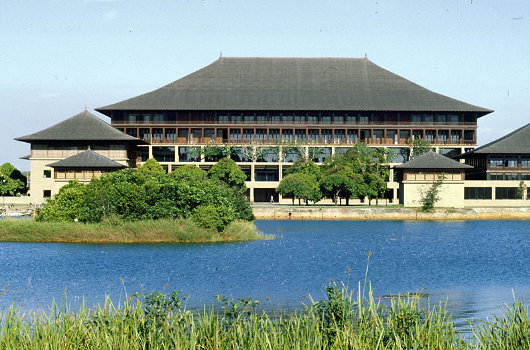
CEYLON IS AN ancient island whose history spans the epochs of human existence: palaeontologists estimate it has been inhabited for over 34,000 years. A series of ancient and medieval native kingdoms have ruled this island over the centuries before foreigners from abroad decided to enter the game. The Portuguese were the first Europeans to stake a claim here, followed by the Dutch Republic. And, yes, as with almost every place of intrigue and tradition, even Ceylon belonged to the Hapsburgs at one point: from 1580 to 1640. Native kingdoms persisted nonetheless, even while European powers bickered over their own portions of the island.
It was in 1815 that the Chiefs of the Kandyan Kingdom agreed to depose their own monarch, Sri Vikrama Rajasinha, and place George III of the House of Hanover on the throne. Ceylon was united at last, and — after the end of the Kandyan Wars — the island enjoyed relative peace and prosperity during one-hundred-and-thirty-three years of British rule.
In 1948, the British granted independence to the Dominion of Ceylon. The island continued as an independent constitutional monarchy for much longer than its neighbours India and Pakistan. The rudiments of a two-party system emerged, with the United National Party bringing together the conservative, traditional element in political society, while the Freedom Party advocated non-revolutionary socialism.
The population of Ceylon, however, are a complete hodgepodge of ethnicities. The largest group are the Sinhalese, a Buddhist people constituting over 70% of the population. But at the northern end of the island, the Tamil people were dominant, even though these were split between “Ceylonian” Tamils native to the island and “Indian” or “Plantation” Tamils brought during British rule to work the large plantations. Then there are the Moors, a multiracial Muslim community of primarily Arab and Malay descent. And, of course, there are the famous Burgher people, descendants of the island’s Portuguese, Dutch, and English mixed with Sinhalese, Tamil, and Creole.
Democratically elected politicans replaced English (the intercommunal lingua franca) with Sinhala (the language of the Sinhalese majority) as the official language, abolished the Senate, severed appeal to the Privy Council and, in 1970, abolished the monarchy. The Dominion of Ceylon was renamed the Republic of Sri Lanka — the name literally means “Venerable Island”. Left-wing nationalists continually stoked tensions with the country’s conservatives, traditional elite, and minorities, and provoked right-wing reactions. Aside from the left-right divide, Tamil extremists began an anti-Sinhalese terror campaign that increased the oppression of the Tamil people and strengthened the country’s divisions. In short, it all became a mess. (more…)
Universitas Carolina Pragensis
The Charles University of Prague
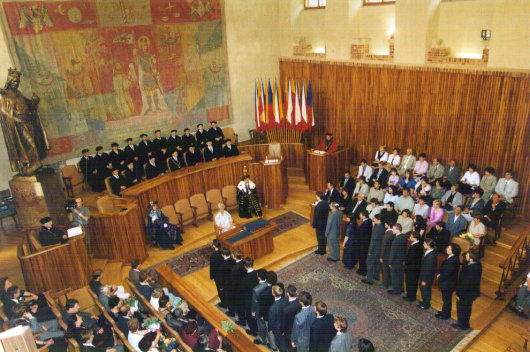
Prague’s university, the Universitas Carolina, was founded in 1347 and this is the first university of the Germans — a nation with a long (if varied) intellectual tradition. In a fashion similar to the medieval university of Paris, the Charles University was divided into “nations”: the Bavarians, the Bohemians, the Poles, and the Saxons. The splendid cosmopolitanism of Christendom was threatened by the challenge of nationalism as early as the 1400s, when the Decree of Kuttenberg stoked ethnic tensions by granting the masters of the Bohemian “nation” at the University three votes to the one vote to be shared amongst the Bavarians, Poles, and Saxons. All of this was provoked by various political power plays during the Western Schism, and the Decree resulted in an exodus of German professors and students to other universities, and indeed inspired the foundation of the university at Leipzig. More lamentable was the election, soon after, of the heretic Jan Hus as rector of the Bohemian-dominated university. No good came from this, but after the fall of the Hussites, order was restored.
In the following centuries the university underwent numerous changes. A new academy, the Clementinum, was founded in 1562. The Jesuits were given control in 1622, and twenty years later Ferdinand III merged the two centers of learning to form the Charles-Ferdinand University. In 1784, German replaced Latin as the language of instruction, and in 1791 Leopold II established a chair of Czech language and literature. By the 1860s, the royal city of Prague no longer had a German-speaking majority, and by then Czech had joined German as a medium of learning. Lamentably, the government decided to split Prague’s university in two on lingual lines: the Royal & Imperial German Charles-Ferdinand University, and the Royal & Imperial Czech Charles-Ferdinand University.
The German university experienced a brief heyday just before the First World War, but America’s entry into the conflict spelt doom not only for Catholic Europe as a whole, but specifically for any peoples who found themselves suddenly a member of an “ethnic minority”, no matter if they had dwelled there for centuries. The new Czechoslovak republic passed laws favouring the Czech University over the German University. With just over 50,000 Germans living in Prague after the dissolution of the Austro-Hungarian Empire, the German University considered moving to Reichenberg (Cz., Liberec) in northern Bohemia, the central city to Czechoslovakia’s German population of some millions, but the academic leadership demurred.
After the 1939 invasion and occupation of Czechoslovakia, the Czech University was closed by the Nazis, who purported the close was temporary, but it remained shut until after the Soviet conquest of Prague in May 1945. The new Soviet-backed Czechoslovak authorities began the immediate ethnic cleansing of all Germans from their territory, irrespective of whether they had actively abetted the Nazis, resisted them, or remained inactive. The German University collapsed, but its remnants fled to Munich, where the Collegium Carolina continues today as a German-language institute for higher studies in Bohemian & Czech culture.
While the Czech University reopened — called simply the Univerzita Karlova v Praze, or Charles University of Prague — its freedom was short-lived as the Communists began their takeover of the Czechoslovak government and society. With the relaxation of restrictions during the 1980s, faculty and students began to voice their dissent from the socialist system, and many participated in the Velvet Revolution that ended political communism in Czechoslovakia. Today, the Charles University is widely recognised as the preeminent academic institution of the Czech Republic.
…en dit is ’n foto van my in Suid-Afrika
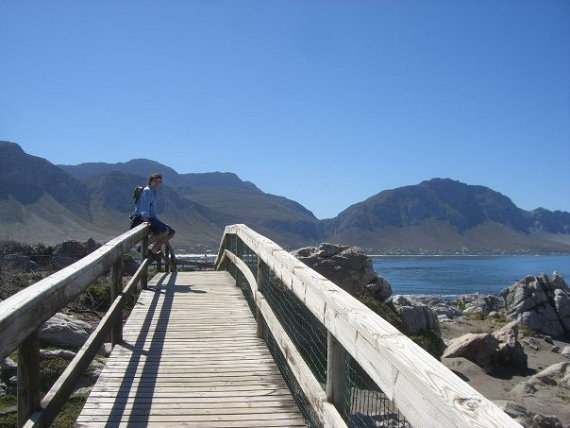
A reader has pointed out that, in all my posts on South Africa, those who frequent this little corner of the web have not seen so much as a single shot of your humble & obedient scribe in that southerly land. Such lack of photographic evidence, our correspondent argues, could provoke a wealth of conspiracy theories locating me, alternatively, within the deep recesses of the Vatican, training a small fighting force in the Salzkammergut, or, somewhat implausibly, in the Democratic People’s Republic of Korea.
(In truth, I have very, very few pictures of myself, as I am usually the one taking the pictures — some of which are electronically submitted for your approval here.)
And so, dear readers, you will find above a photograph of yours truly on one of my trips to Betty’s Bay, that splendid corner of the Cape.
Kiest Welter
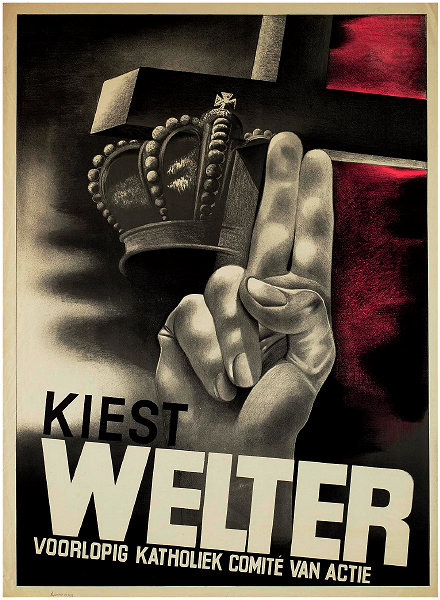
Christianity — Monarchy — Loyalty. This Dutch election poster urges voters to “Choose Welter”, referring to the sometime Dutch government minister Charles Welter. (more…)
Praga Caput Regni
Prague: Capital & Head of the Bohemian Realm
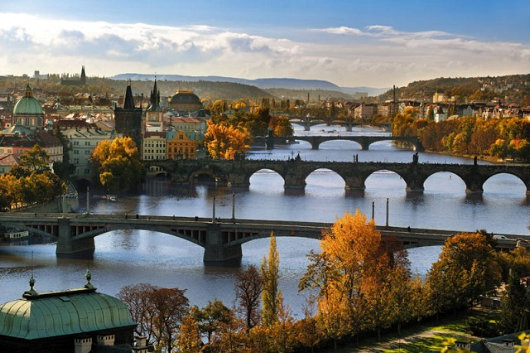
Prague is traditionally known as “Praga Caput Regni” — the capital of the realm, or indeed the head of the Bohemian body. Changing times and a different form of government mean that the arms of this ancient city now bear the motto “Praga Caput Rei Publicae” instead. The photographer Libor Sváček was born in the be-castled city of Krummau, and has a splendid book of photographs of that town, but here are a number of his photographs of Prague, which splendidly exhibit the Old Town at its most beautiful. (more…)
Gorham’s Pond Bridge
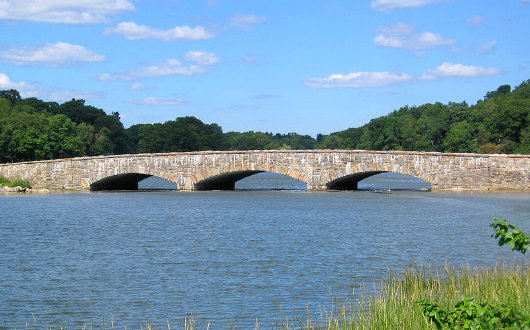
Gorham’s Pond Bridge spans the Goodwives River in Connecticut. Captain George Gorham was born in January 1696 (O.S.) at Barnstable in the Province of Massachusetts Bay. The Captain married Hannah Banks, a Greenwich girl, in 1726 and bought the grist mill in 1740. While most of this neck of the woods leaned towards the Rebels during the Revolution, Robert Gorham was a staunch Tory. From time to time, fellow Tories would land at Gorham’s Mill to raid local Rebel strongholds. After disturbing a meeting at the Congregational Meeting House — a local den of rebellion — the Rebels hid behind a stone wall waiting to ambush the Tories at an expected raid. The Tories, however, got wind of the plotted ambush, and snuck up behind the Rebels, launched a surprise attack, and duly won the skirmish.
Unusually, the revolutionary authorities allowed the Gorhams to remain in Connecticut, and their property was not confiscated. The family owned the Mill until it was destroyed by fire in the first half of the twentieth century. Gorham’s Landing is now within the town of Darien, and nearby is the Convent of St. Birgitta at Vikingsborg.

Quiringh Gerritsz. van Brekelenkam, Family Group at Dinner Table
Oil on canvas, 22 5/8 x 28 3/8 in.
1658-1660, J. Paul Getty Trust
Note: Previously attributed to Cornelis de Man.
A Tale of Two Headscarves
In Deference to Islam, U.S. Secretary of State Dons Headscarf, while that of Canadian Governor-General Michaëlle Jean is Conspicuous in its Absence
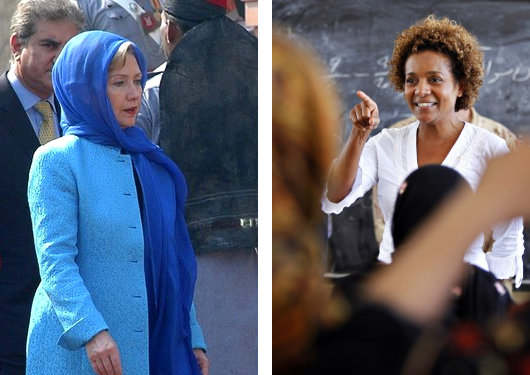
In the clash of civilisations between Islam and “the West”, there are Churchills and there are Chamberlains. A recent New York Times front-page photo shows U.S. Secretary of State Hillary Clinton donning a headscarf on her recent visit to Pakistan. But Michaëlle Jean, Canada’s Governor-General (and thus that country’s highest-ranking official after the Queen), recent journeyed to the “Af-Pak” region herself. Photos released by Rideau Hall show Her Excellency breezily taking questions from girls in an Afghan school build with Canadian development funds. The photos show a woman who appears free, confident, and easily engaged by her interactions with those around her. The contrast with Secretary Clinton couldn’t be greater.
The advice si fueris Romae, Romano vivito more, traditionally attributed to no less a sage than St. Ambrose, is sound counsel indeed, but one can’t help but wonder if in this circumstance the Governor-General’s way is the more appropriate one. How rare it is that we find Western leaders with enough self-assurance not to pander deferentially towards a culture alien to our own. Secretary of State Clinton, in her headscarf, broadcasts the signal that she is following an agenda set by others, whereas Governor-General Jean chooses to set the agenda herself — fitting for the viceroy of one of the most stable countries in the world, that enjoys an enviable constitutional longevity.
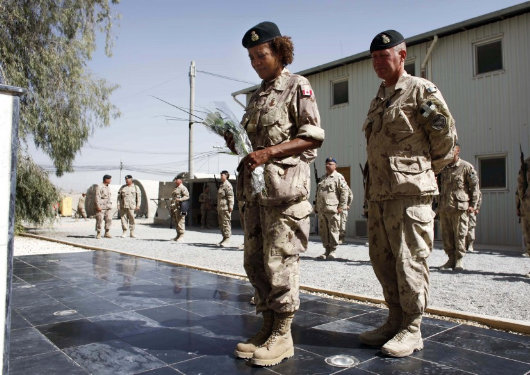
Still, the Governor-General’s head did not remain bare for the entirety of her visit to Afghanistan. Her Excellency is Colonel-of-the-Regiment of the three units of Canada’s household guard, and, donning the military beret, Madame Jean visited a memorial to the soldiers of her country who have given their lives in the endless conflict in Afghanistan. After the proper solemnities were observed, the Governor-General took a few moments to meet with some of the Canadian soldiers who stood guard during the ceremony.
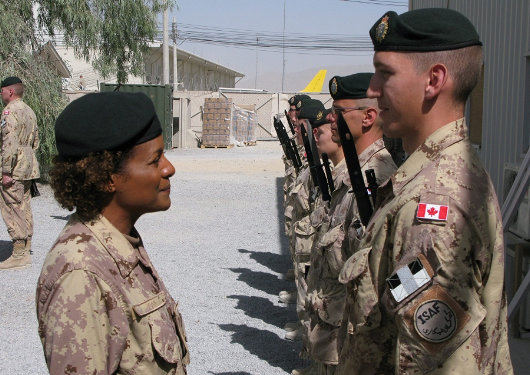
Wits Scientists Unearth Afrikaans Dinosaur in the Orange Free State
Bones of “Aardonyx Celestae” on Display at the Transvaal Museum
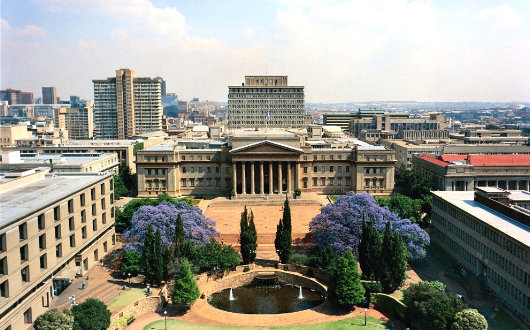
A NEW SPECIES OF dinosaur has been discovered in South Africa by a team of researchers from the University of Witwatersrand (above, colloquially known as “Wits”), and has been given an appropriately Afrikaans moniker. The new classification of Aardonyx Celestae is a combination of Afrikaans, Greek, and Latin meaning “Celeste’s Earth-claw”, after the female team member who first handled the speciment. The 23-foot long collection of fossils was found near Bethlehem in the Orange Free State, and, after the announcement before the gentlemen of the press, the bones are now displayed at the Transvaal Museum in the South African capital of Pretoria.
The specimen discovered is about 195 million years old, dating from the Early Jurassic Period (presuming one actually doubts Ussher’s chronology). Limb proportions lead the experts to believe that Aardonyx was a biped, although its forearm bones interlock (like those of quadrupeds) suggesting that it could occasionally walk on all-fours.
Unlike most Afrikaners, though, Aardonyx was a vegetarian, taking in huge mouthfuls of vegetation through its broad jaw.
Swinging round the Cape Peninsula
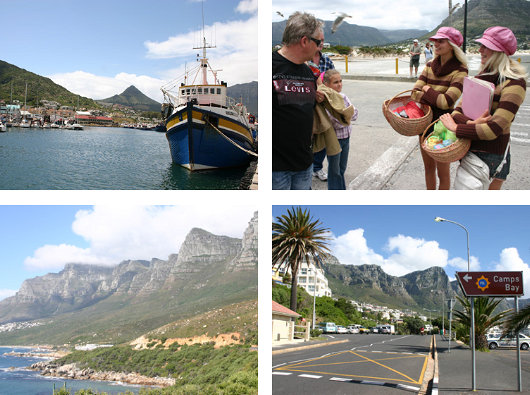
Visual editor and blogger Charles Apple gives us a photographic depiction of his Saturday touring the Atlantic side of the Cape Peninsula, from the V&A Waterfront, to Green Point, Three Anchor Bay, Sea Point, Clifton, Maiden’s Cove, Camps Bay, Bakoven, the Twelve Apostles, Llandudno, Hout Bay, and Chapman’s Peak. The photos are good, but still don’t do justice to that beautiful part of the world. They do, however, get me pining for the Peninsula!
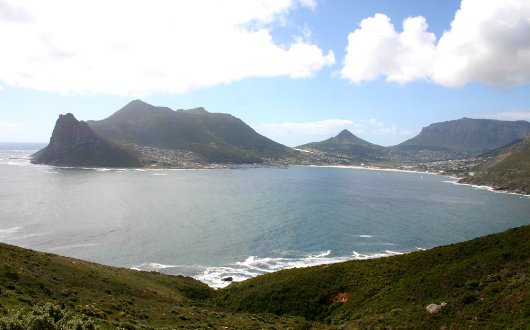
The Senate of South Africa
Die Senaat van Suid-Afrika
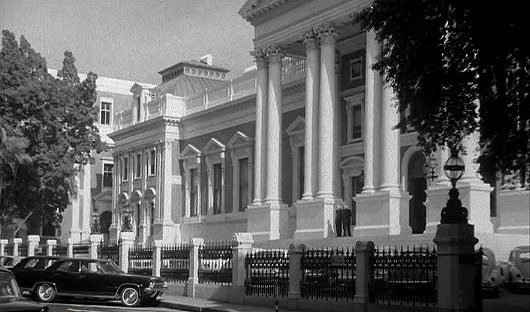
THE SENATE OF South Africa has had something of a tempestuous history, a fact which is attested to by the vicissitudes of the Senate chamber in the House of Parliament in Cape Town. The Senate formed the upper house of South Africa’s parliament from the unification of the country in 1910, in accordance with the proposals agreed to by Briton & Boer at the National Convention of 1908. Its members were originally selected by an electoral college consisting of the Provincial Councils of the Cape, the Transvaal, the Orange Free State, and Natal, and the members of the House of Assembly (the parliament’s lower house), along with a certain number of appointments by the Governor-General on the advice of the Prime Minister. When South Africa abolished its monarchy, the State President took over the appointing role held until then by the Governor-General, but the Senate remained largely intact until 1981, when it was abolished in advance of the foolish introduction of the 1984 constitution with its racial tricameralism.
The Senate made a brief comeback in 1994, when the interim constitution provided for a Senate composed of ninety members, ten elected by each of the provincial legislatures of the new provinces. The 1994 Senate, however, was replaced by the “National Council of Provinces” in the final 1997 constitution. (more…)
How “New Yorker” is the Staats-Zeitung?

When I was a youngin’, one of the joys of Sundays was the trip to the bakery and the newsagent after church. A vast array of newspapers was on hand for perusal while Pop nipped into Topps Bakery next door. We usually only bought The European, but I browsed everything on hand. One of the available titles was the New-Yorker Staats-Zeitung, founded in 1834, and the oldest German newspaper in the New World. The “Staats” was daily from 1854 until 1953, when it went weekly. In the late 1930s, the circulation was about 80,000, falling to 25,000 in the late 1990s, and stands around 10,000 today. It seems a pity that this “New York” newspaper is now edited from Sarasota, Florida instead of from Manhattan, but at least the Staats-Zeitung survives.
The new look of things
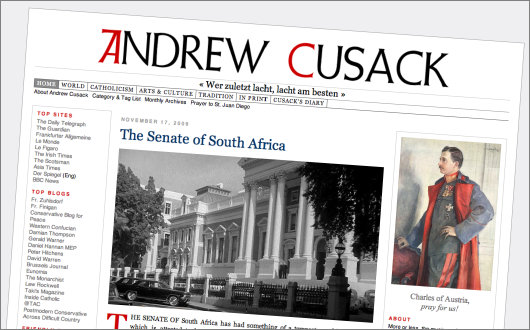
Bienvenue, baie welkom, and whatnot to the latest version of andrewcusack.com. Changes here are usually quite slow and evolutionary, but I got bitten by the redesign bug and this latest incarnation of our little corner of the web is what I came up with. There might be some kinks yet to be worked out with it, as time will shortly tell. The new WordPress theme I have designed, for those who are interested in such mundane things, is named “Göteborg” (the previous one I rather boringly named “ALPHA”), and there are few (though we hate the word) “improvements” perhaps worth mentioning. (more…)
Search
Instagram: @andcusack
Click here for my Instagram photos.Most Recent Posts
- Burns Tower April 19, 2024
- Patrick in Parliament March 18, 2024
- Articles of Note: 13 March 2024 March 13, 2024
- Cambridge March 9, 2024
- Taken on Trust March 4, 2024
Most Recent Comments
Book Wishlist
Monthly Archives
Categories


